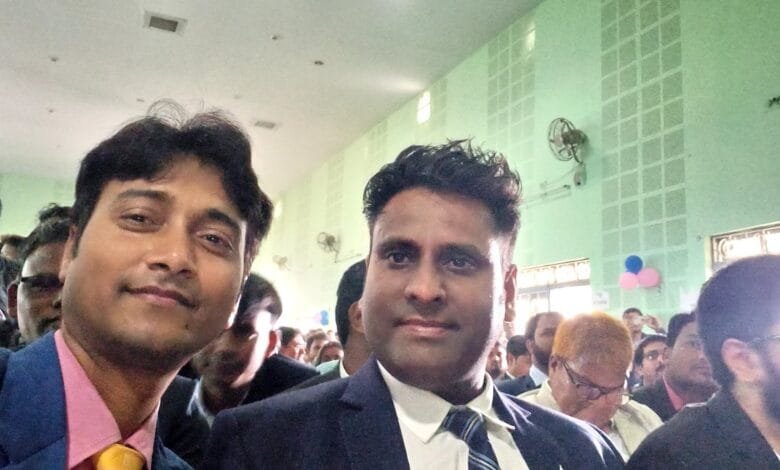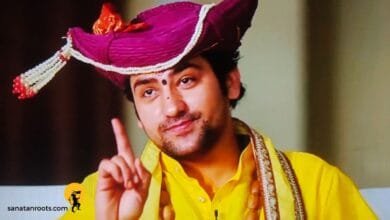रवि ओ.पी. शर्मा का वायरल वीडियो: “₹100 करोड़” कारोबार, लग्ज़री कारें और नेटवर्क मार्केटिंग के सपने

अक्टूबर 2025 में भारत के सोशल मीडिया प्लेटफ़ॉर्म्स पर एक वीडियो ने धूम मचा दी। एक करिश्माई नेटवर्क मार्केटर, रवि ओ.पी. शर्मा, अपने भव्य जीवन, करोड़ों के कारोबार और लग्ज़री कारों के दावों के साथ इंटरनेट पर छा गए। कुछ लोग उन्हें प्रेरणा मान रहे हैं, तो कुछ इस पूरे मॉडल पर सवाल उठा रहे हैं।
₹100 करोड़ के दावे और वायरल वीडियो
रवि शर्मा का दावा है कि उनका मासिक कारोबार ₹100 करोड़ से अधिक है और वे हर महीने ₹6 लाख GST भरते हैं। उनके पास Mercedes, BMW, Audi, Skoda और Kia जैसी कई महंगी कारें हैं। लेकिन जिसने लोगों को सबसे ज़्यादा आकर्षित किया, वह उनका बोलने का अंदाज़ है — आत्मविश्वास, ड्रामा और हर वाक्य में “मैंने कर दिखाया” की झलक।
एक दिन में कई “ट्रांसफॉर्मेशन”: मोती से नीलम तक
वीडियो का सबसे मशहूर हिस्सा वह है जहाँ शर्मा बताते हैं कि वे एक ही दिन में कई बिजनेस लेवल हासिल कर लेते हैं।
“सुबह 7 बजे मैं ‘Star Pearl’ होता हूँ, 10 बजे ‘Emerald’ बन जाता हूँ, 11:30 पर ‘Star Emerald’, 2 बजे ‘Ruby’, शाम 4 बजे ‘Star Ruby’ और रात 9 से 10 के बीच ‘Sapphire’। अगले दिन मैं ‘Star Sapphire’ बन जाता हूँ।”
यह बयान इंटरनेट पर मीम्स का विषय बन गया। लोग इसे Duggal साहब जैसे किरदारों से तुलना करने लगे जो हर दिन अपना रूप बदलते थे — फर्क बस इतना कि रवि शर्मा दिन में कई बार रूप बदल लेते हैं!
GST और इनकम पर खुलकर बात
शर्मा अपने वीडियो में कहते हैं,
“मैं हर महीने ₹6 लाख GST देता हूँ, सर। इनकम अलग है — उसे आप गिनते रहिए।”
यह बयान दर्शाता है कि वे अपनी आय को “कानूनी और पारदर्शी” बताना चाहते हैं, ताकि उनके दावे पर भरोसा बढ़े।
कारों का शौक और “Rolls Roy” का सपना
शर्मा बताते हैं कि उन्हें अब अपनी कारों की गिनती याद नहीं रहती, लेकिन फिर भी सूची पढ़ देते हैं — Mercedes, दो BMWs, Audi, Kia Seltos, Skoda और हाल ही में खरीदी गई Scorpio।
उनका बड़ा सपना है — 2030 से 2035 के बीच “Rolls Roy” (Rolls-Royce) खरीदना, जिसकी कीमत वे “सिर्फ ₹8 करोड़” बताते हैं।
वे कहते हैं, “मेरी BMW X5 के एक टायर की कीमत ₹50,000 है, और मीटिंग में आने-जाने में ₹25,000 पेट्रोल खर्च हो जाता है।”
बड़े वादे, बड़ी बातें
नेटवर्क मार्केटिंग की पिच यहाँ साफ़ दिखती है। शर्मा अपने दर्शकों से कहते हैं —
“अगली बार लोगों की संख्या बढ़ाओ, हम तुम्हारे लिए कार लाएँगे। अगर 5,000 लोग बैठाओगे, तो मैं हेलीकॉप्टर से उतरूँगा।”
ऐसे बयान दर्शकों को प्रेरित करते हैं, लेकिन यह भी दिखाते हैं कि सफलता को “लोग जोड़ने” से जोड़ा जा रहा है, न कि असली बिक्री या उत्पाद से।
रवि शर्मा कौन हैं?
वीडियो वायरल होने के बाद लोगों ने उनकी खोजबीन शुरू की। बताया जाता है कि वे जयपुर, राजस्थान के रहने वाले हैं, और उनके पिता भी इसी नेटवर्क मार्केटिंग कंपनी से जुड़े हुए थे।
वे कहते हैं कि उन्होंने एक भव्य कॉम्प्लेक्स बनाया है, जहाँ उन्होंने एक बड़ा एक्सपीरियंस सेंटर खोला है — “क्योंकि रवि शर्मा सिर्फ बातें नहीं करते, कर दिखाते हैं।”
सोशल मीडिया पर मीम्स और प्रतिक्रियाएँ
उनके “Rolls Roy” उच्चारण, दिन में कई स्तरों में बदलने की बात और ज़रूरत से ज़्यादा आत्मविश्वास ने उन्हें मीम्स का पसंदीदा विषय बना दिया।
Instagram और YouTube पर उनके वीडियो पर हज़ारों व्यूज़ और जोक्स बने। लेकिन हंसी के बीच यह सवाल भी गूंजा — क्या ये सब असली है, या बस मार्केटिंग का खेल?
नेटवर्क मार्केटिंग की सच्चाई
जैसा कि “The Lallantop” ने लिखा —
“इतिहास गवाह है और भविष्य साक्षी रहेगा कि जो आम लोगों को बड़े-बड़े सपने दिखाता है, वह ज़्यादातर नेटवर्क मार्केटिंग से जुड़ा होता है।”
नेटवर्क मार्केटिंग (या MLM) एक ऐसा ढांचा है जिसमें सदस्य अपनी बिक्री के साथ-साथ नए सदस्यों को जोड़कर कमीशन कमाते हैं। सफलता का वादा बड़ा होता है, लेकिन आँकड़े कुछ और कहते हैं।
- अधिकांश लोग कभी टॉप लेवल तक नहीं पहुँच पाते
- बहुतों का पैसा, समय और रिश्ते इसमें खत्म हो जाते हैं
- दावे सत्यापित नहीं होते
- ज़्यादातर फोकस “भर्ती” पर होता है, “उत्पाद” पर नहीं
“मोटिवेशन” की मार्केटिंग
शर्मा की शैली तीन चरणों में चलती है:
- क्रेडिबिलिटी बनाना — लक्ज़री कारें और आँकड़े दिखाना
- ट्रांसफॉर्मेशन दिखाना — यह जताना कि सफलता पलक झपकते आ सकती है
- कॉल टू एक्शन — दर्शकों से कहना, “लोग जोड़ो, सफलता मिलेगी”
यह स्ट्रक्चर भावनाओं पर खेलता है। जो लोग जल्दी सफलता चाहते हैं, उनके लिए ये बातें सुनने में आकर्षक लगती हैं।
सावधानी जरूरी है
ब्लॉग में लिखा गया है —
“शायद रवि शर्मा करोड़पति हों, लेकिन जो लोग उनके नेटवर्क से जुड़ रहे हैं, उन्हें सतर्क रहना चाहिए।”
सफलता की कहानियाँ प्रेरक हो सकती हैं, पर यह मान लेना कि हर कोई वैसा कर सकता है — यही सबसे बड़ा भ्रम है।
इसलिए:
- किसी भी नेटवर्क योजना में शामिल होने से पहले पूरी जानकारी लें
- आँकड़ों की सच्चाई जांचें
- अपनी पूंजी, समय और सामाजिक संबंधों की कीमत समझें
- अगर कोई ऑफर “बहुत अच्छा” लगता है, तो संभव है कि वह सच न हो
निष्कर्ष: प्रेरणा या भ्रम?
रवि ओ.पी. शर्मा ने वायरल प्रसिद्धि हासिल कर ली है। उनके वीडियो ने यह चर्चा शुरू कर दी है कि भारत में नेटवर्क मार्केटिंग कैसे लोगों की उम्मीदों और भावनाओं पर खेलती है।
शायद वे सचमुच सफल हों — लेकिन असली सीख यह है कि किसी भी चमकदार मंच से बिकने वाले सपनों पर आँख मूँदकर भरोसा नहीं करना चाहिए।
लक्ज़री कारें, “Rolls Roy” के सपने, हेलीकॉप्टर की एंट्री — ये सब देखने में मनोरंजक हैं, लेकिन असली जीवन में सफलता पसीने, समय और सच्ची मेहनत से बनती है — न कि चमत्कारिक दावों से।
अस्वीकरण (Disclaimer):
यह ब्लॉग सार्वजनिक रूप से उपलब्ध वीडियो और सूचनाओं पर आधारित है। इसमें दिए गए सभी दावे वही हैं जो रवि ओ.पी. शर्मा ने अपने वायरल वीडियो में किए हैं। किसी भी व्यावसायिक निर्णय से पहले स्वतंत्र रूप से सत्यापन करें।
Discover more from Sanatan Roots
Subscribe to get the latest posts sent to your email.



